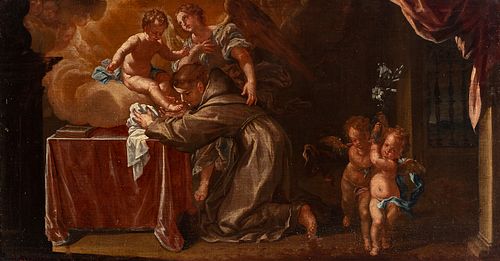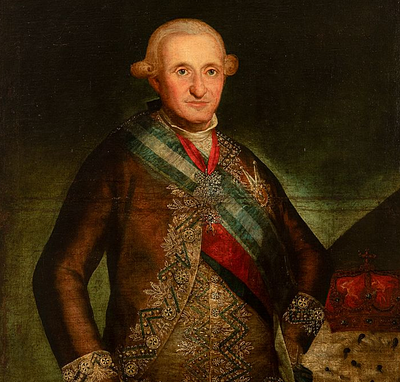Spanish master; c. 1700. "San Antonio de Padua with Child" Oil on canvas. Relined.
Lot 23
About Seller
Setdart Auction House
Carrer Aragó 346
Barcelona
Spain
Setdart Subastas was born in 2004 and is currently the first online art auction in Spain with solidity, prestige and reliability guaranteed by our more than 60,000 users. Setdart has a young, dynamic and enterprising team ready to successfully manage the purchase and sale of art works through custom...Read more
Estimate:
EUR€3,500 - EUR€4,000
$3,608.25 - $4,123.71
Absentee vs Live bid
Two ways to bid:
- Leave a max absentee bid and the platform will bid on your behalf up to your maximum bid during the live auction.
- Bid live during the auction and your bids will be submitted real-time to the auctioneer.
Bid Increments
| Price | Bid Increment |
|---|---|
| EUR€0 | EUR€10 |
| EUR€200 | EUR€25 |
| EUR€500 | EUR€50 |
| EUR€1,000 | EUR€100 |
| EUR€3,000 | EUR€200 |
| EUR€5,000 | EUR€500 |
| EUR€10,000 | EUR€1,000 |
| EUR€20,000 | EUR€2,000 |
| EUR€50,000 | EUR€5,000 |
About Auction
By Setdart Auction House
Sep 22, 2021
Set Reminder
2021-09-22 09:30:00
2021-09-22 09:30:00
America/New_York
Bidsquare
Bidsquare : 22nd September - ARAS JÁUREGUI Private Collection - Old Masters, 19th & 20th Century
https://www.bidsquare.com/auctions/setdart-auction-house/22nd-september---aras-j-uregui-private-collection---old-masters-19th-20th-century-7427
ARAS JÁUREGUI Private Collection - Old Masters, 19th & 20th Century Setdart Auction House sofia@setdart.com
ARAS JÁUREGUI Private Collection - Old Masters, 19th & 20th Century Setdart Auction House sofia@setdart.com
- Lot Description
Spanish master; c. 1700. "San Antonio de Padua with Child" Oil on canvas. Relined. Presents, missing repainting and frame from the beginning of the 20th century. Measurements: 53 x 102 cm; 73 x 122 cm (frame). Oil on canvas of devotional character, representing Saint Anthony of Padua and the Infant Jesus. In front of the saint, kneeling and completely naked, except for the purity cloth, we see the Child Jesus floating in the sky, on a background of golden clouds that indicate a great break of glory. Jesus is looking directly at the saint, and moves his right hand towards the saint's head in an attitude of blessing. The position of both figures is typically baroque: the saint opens his hands in a sign of acceptance, while humbly bowing his face. The Child, on the other hand, is in the opposite position, with a typically Baroque ascending, rotating movement, which is contrasted by the head bent downwards to look at the saint. The two figures are arranged in different spaces, one in the heavenly space and the saint in the earthly one, but both are in the foreground, displaced to the left of the composition. The composition is conceived in the manner of a frieze, which allows a certain depth to be seen thanks to the window on the right-hand side of the painting. Despite the bars, it allows a view of a dark sky landscape. The scene is completed by the presence of several angels, one of which is a larger angel between the saint and the Infant Jesus, and two other small angels holding flowers, a characteristic attribute of Saint Anthony of Padua. St. Anthony of Padua is, after St. Francis of Assisi, the most popular of the Franciscan saints. He was born in Lisbon in 1195 and only spent the last two years of his life in Padua. After studying at the convent of Santa Cruz in Coimbra, he entered the Order of Friars Minor in 1220, where he changed his Christian name from Fernando to Antonio. After teaching theology in Bologna, he travelled through southern and central France, preaching in Arles, Montpellier, Puy, Limoges and Bourges. In 1227 he took part in the general chapter at Assisi. In 1230 he was involved in the transfer of the remains of St. Francis. He preached in Padua and died there at the age of 36 in 1231. He was canonised only a year after his death, in 1232. Until the end of the 15th century, the cult of St. Anthony remained located in Padua. From the following century onwards, he became, at first, the national saint of the Portuguese, who placed the churches they built abroad under his patronage, and then a universal saint. He is depicted as a beardless young man with a broad monastic tonsure, dressed in the brown habit of the Franciscans. One of his most frequent attributes is the book, which identifies him as a sacred writer. Another distinctive iconographic feature is the branch of lily, an element borrowed from his panegyrist Bernardine of Siena. Saint Anthony is often depicted with the Infant Jesus, alluding to an apparition he had in his cell. It became the most popular attribute of this saint from the 16th century onwards, and was particularly popular in the Baroque art of the Counter-Reformation.
- Shipping Info
-
In-house shipping available. Please inquire at admin@setdart.com.
-
- Buyer's Premium



 EUR
EUR CAD
CAD AUD
AUD GBP
GBP MXN
MXN HKD
HKD CNY
CNY MYR
MYR SEK
SEK SGD
SGD CHF
CHF THB
THB

















